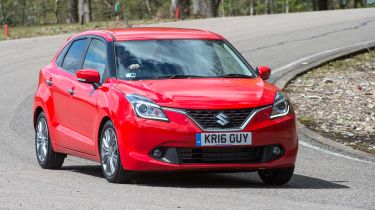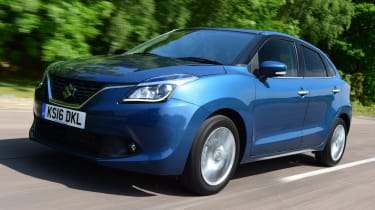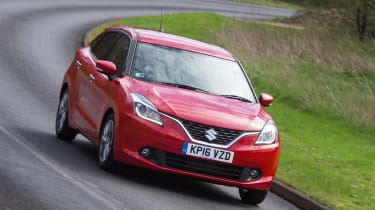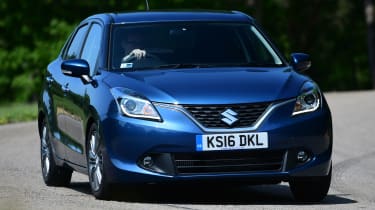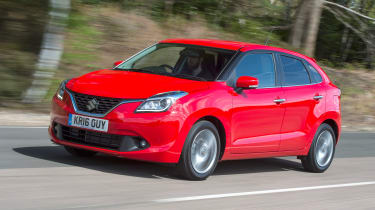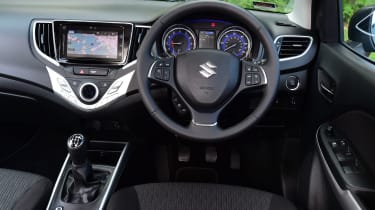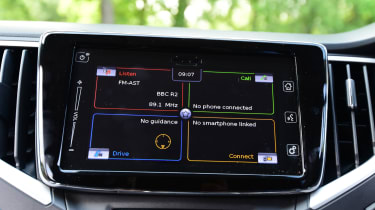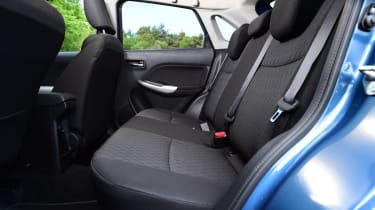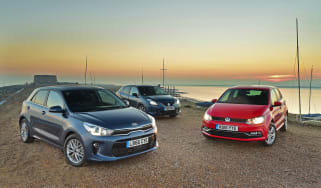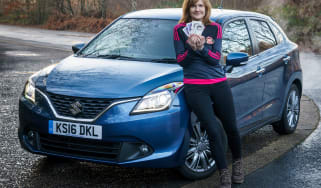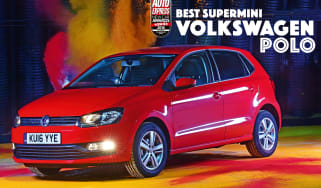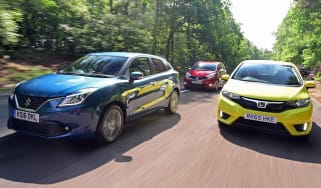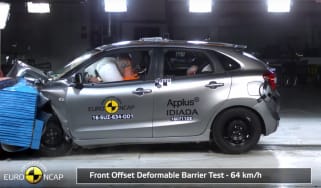Suzuki Baleno (2015 to 2022) review
The Suzuki Baleno supermini sits alongside the Swift as a more practical small car offering, but does it serve any purpose?

There are two things that Suzuki is good at building: small cars and 4x4s. The Suzuki Baleno is another entrant into the small car class, although it falls somewhere between the supermini and compact hatchback classes in terms of size.
Suzuki has a variety of small cars, and the Baleno is the largest it offers. It's based on the same platform as the new Swift, and it also shares tech with the recently launched Ignis small crossover. The rounded shape is designed to offer something sensible in comparison to the youthful and funky Swift and Ignis, and a fringe benefit of those looks is that the Baleno is one of the most spacious cars at this price level.
The name Baleno is a blast from Suzuki's past, as it was last used on a fairly unexciting saloon and hatch. The current Baleno was launched in 2015, and it's only offered as a five-door supermini. Prices start from around £12,000, while even the most expensive model only comes in at around £16,500.
There are two core engines in the range, one is a 1.2-litre four-cylinder, while the other is Suzuki's three-cylinder turbo petrol, called Boosterjet. In addition, Suzuki also offers a mild hybrid system for the 1.2 called SHVS. This adds a high capacity battery that boosts acceleration and fuel efficiency as it harvests energy under braking.
Used - available now

2018 Peugeot
208
34,470 milesManualPetrol1.2L
Cash £7,649
2022 Volvo
XC40
50,641 milesAutomaticPetrol2.0L
Cash £20,697
2023 Tesla
Model 3
21,783 milesAutomaticElectric
Cash £18,197
2024 BMW
1 Series
33,177 milesAutomaticPetrol1.5L
Cash £19,897There are three trims on offer - SZ-3, SZ-T and SZ5. SZ-3 comes with the 1.2-litre petrol, while the SZ-T and SZ5 come with the 1.0-litre Boosterjet engine, and the latter is also offered with an auto gearbox. The SHVS hybrid system is only available on the 1.2 SZ5 model. There is no diesel model available, and all cars come with a five-speed gearbox as standard.
Rivals for the Baleno consist of the usual supermini suspects, including the Ford Fiesta, Vauxhall Corsa and Skoda Fabia. In terms of space, the Honda Jazz is cleverly packaged to deliver decent room, while Suzuki's own Swift and Ignis are worth considering. If you want Far Eastern reliability, then the Hyundai i20, Kia Rio, Toyota Yaris and Nissan Micra are all well worth checking out.
Suzuki has created a bit of a hidden gem with the Baleno. Behind its polarising exterior lies a decent drive that's shared with the more conventional Swift, while its larger dimensions create a superbly spacious interior. On top of that, the standard kit list on top-spec models mean this is an extremely well equipped supermini for the money. Running costs are also low, yet performance is peppy thanks to its light weight and the use of simplified hybrid technology. If you can live with cheap-feeling interior plastics, there’s little else in the class that offers so much for such a small outlay.
Engines, performance and drive
The Baleno is part of Suzuki’s split between the ‘rational’ (which is where this car sits) and the ‘emotional’ (which is where the Swift is targeted). However, the Baleno is actually better to drive than this might lead you to believe.
It’s based on a new platform that makes it one of the lightest, yet most spacious, superminis around. All models weigh less than 950kg, which is impressive given it can carry four large adults in comfort. That lack of weight benefits the Baleno’s handling, performance and efficiency.
Even though most buyers might not care how the Baleno rides or handles, it’s a bonus that it manages to be fairly good in both respects. The soft suspension means it rolls about a bit in the bends, but it feels quite agile and peppy, despite fairly light steering that’s lacking in feel.
Grip levels are decent, too, but the Swift is still the model you’ll want for ultimate fun. A comfort bias means the ride is pretty good, although the lightness means it can get unsettled by bigger lumps and bumps. It’s no Skoda Fabia for ride quality, but it’s not bad.
One area which could be improved is refinement. At higher speeds wind and road noise can make themselves known, while the lack of a sixth gear on either model means it can generally get a bit buzzy at motorway speeds. There are worse offenders at this price, but the Baleno is a way off the noise suppression standards you’d find in a Volkswagen Polo.
Engines
Suzuki has launched not one but two engines with the Baleno – both of them petrols. The 1.0-litre Boosterjet is a three-cylinder direct injection turbocharged petrol, while there’s also a 1.2-litre SHVS mild hybrid.
Producing 109bhp and 170Nm of torque, it’s roughly on a par with the 1.0-litre turbos found in the Vauxhall Corsa and Hyundai i20. Don’t be put off by the leisurely 0-62mph time of 11.4 seconds – it feels a lot faster than that, and Suzuki is often very conservative with its performance figures.
Despite making do with a five-speed gearbox, the Baleno feel strong and flexible with plenty of urgency in-gear. Like most of these downsized engines, it’s at it’s best lower down in the rev range – there’s a soft limiter at about 5,500rpm which might catch you by surprise. It’s also smooth and refined when you’re taking it easy, you do get a tell-tale vibration at idle but the three-cylinder noise it makes when revved is sporty. It’s also the only Baleno engine that comes with a six-speed automatic gearbox option.
It’s enough to make it the pick of the Baleno’s two-strong engine range, but don’t disregard the 1.2-litre SHVS engine. It’s based on the familiar Dualjet naturally-aspirated petrol unit you’ll find in the swift, but it deploys a clever ‘mild hybrid’ system. This uses an electric starter motor to assist the petrol engine in certain situations, including in stop-start traffic. It’s not a full hybrid, though, so you can’t run it in electric-only mode around town.
What the hybrid system does mean is great efficiency figures, both in the real-world and in test conditions. It’s also a very light and simple way of making a hybrid, as the hybrid Baleno actually weighs 15kg less than the turbo petrol. However, it’s not as fast as the Boosterjet turbo, producing 89bhp and a rather measly 120Nm of torque. Thanks to the kerbweight it’s not gutless, it just requires revving to get the best out of it. For buyers who aren’t worried about performance it could make sense, but the 1.0-litre turbo is a more relaxing motorway companion.
MPG, CO2 and Running Costs
The same lightness that gives the Baleno strong performance and a decent drive also benefits fuel economy. Our pick of the range, the 1.0-litre turbo petrol, manages a claimed 62.7mpg combined. Our real-world tests showed it comes closer to matching those figures in the real-world than a number of rivals, including the Ford Fiesta Ecoboost, managing over 50mpg in mixed driving.
• Suzuki Baleno vs Honda Jazz vs Nissan Note
The other engine choice is the one to go for if running costs are your sole priority. The SHVS mild hybrid petrol manages a claimed 70.6mpg combined and emits just 94g/km of CO2. While that doesn’t come close to matching the Toyota Yaris hybrid on paper, it’s still very strong considering the car’s price.
Insurance
The Baleno’s insurance groups are expected to be quite low for the class. There’s no low-powered petrol to suit first time drivers, like you’ll find in a Polo or Fiesta, but the hybrid should fit into a single digit insurance group. The turbo petrol also fits into a reasonable group 11. The only thing holding base models back is a disappointing 3 star Euro NCAP safety rating.
Depreciation
As the Baleno is such a new car and doesn’t directly replace anything, it’s difficult to predict exact residual values, Nevertheless, our experts estimate it will retain between 37 and 44 per cent of its value after three years, meaning the cheapest Baleno SZ-T will be worth just £5,850. That’s behind traditional superminis like the Skoda Fabia, but on a par with supermini MPVs like the Nissan Note.
Interior, design and technology
Suzuki is marketing its Baleno as the ‘rational’ choice in the small car sector, and that shows in the exterior styling. It’s not unattractive, but it’s quite sober and unexciting, even compared to the current Swift. Suzuki as a brand lacks styling cohesion through its model range, with models like the Vitara and Celerio looking totally different from one another. The Baleno is no different.
The new supermini does debut a new design language for the firm, with fewer sharp angles and more curves and soft surfaces. Both the front and rear end get chrome detailing, with the strip at the back looking rather aftermarket in certain colours. However, the details help make it look bigger on the road and differentiate it from the Swift.
Inside, there’s even less to shout about. It’s a sea of black plastic, and the bland design is only brightened up by some metal effect trim on the air-vents, gearlever and door handles. There are some soft touch plastics, but not many and trim quality is variable at best. The flimsy feeling doors do little to aid this, but that’s the downside of having such a light car. At least it’s all screwed together fairly well.
You can forgive the Baleno’s lacklustre trim quality, however, when you look at amount of kit it gets. Even base models get sat-nav, Bluetooth and a DAB radio, while big car features like adaptive cruise control come as standard on high spec models.
Sat-nav, stereo and infotainment
Suzuki uses two different infotainment systems in its cars – the Bosch-based set-up here in the Baleno and a Pioneer unit found in the Ignis city car. All versions of the Baleno get the same set-up, which features sat-nav as standard, as well as Apple CarPlay and MirrorLink for easier smartphone integration.
The seven-inch touchscreen is organised into four different zones, allowing easy access to the major functions of sat-nav, telephone, audio and connectivity. The screen responds promptly and the clear graphics make it easy to access the various functions.
Route planning is easy to programme and the 3D mapping is simple to follow. However, we've found that there were occasional glitches when syncing devices to the unit, which is an issue that has also been highlighted by owners. That said, a software update often cures any issues. Other standard features include a DAB digital tuner and a reversing camera.
Practicality, comfort and boot space
While it's not be the most stylish supermini around, the Baleno is without doubt one of the most practical. It may not have the versatile MPV-style seating arrangement you’ll find in the Honda Jazz but if you’re after a spacious supermini the Baleno is a great choice.
The driving position is good and adjustable and even with the tallest of drivers behind the wheel, passengers in the back will still have sufficient knee room. Unlike some of its rivals the Baleno only comes as a five-door model.
Size
Suzuki has tried to make its two superminis very distinct from one another. The Swift is seen as the more sporty option, while the Baleno is the more practical offering. That’s why the Baleno is the larger of the two – and one of the largest superminis in its class. That translates to impressive interior space for its footprint.
Leg room, head room and passenger space
Like in most superminis, three adults will still feel a bit cramped in the back, but there’s more than enough room for two. Knee room is quite generous, thanks to the Baleno’s increased length, while headroom is plentiful enough for six footers.
Boot
The Baleno offers practicality that you don’t get from cars like the VW Polo or Ford Fiesta, with the rear end hiding a 320-litre boot. In fact, that boot capacity is larger than some models from the class above. The larger and more expensive Ford Focus only has a 316-litre boot.
Although this is a larger capacity than in more conventional superminis, the Baleno doesn’t have the clever rear seat arrangement of the Honda Jazz, which is why it only offers 1,085 litres of luggage space with the back seats folded.
Reliability and Safety
Suzuki finished 19th in our Driver Power 2016 customer satisfaction survey, which was a big improvement on the brand’s 31st-place ranking in 2015. Suzuki’s seventh place in the reliability category – plus the fact many of the parts in the Baleno are borrowed from elsewhere in the range – means the car should hopefully prove to be dependable.
As the SZ5 trim level gets Suzuki’s extra protective kit as standard, the Baleno scored a four-star Euro NCAP rating, so that’s the one to choose. Safety equipment includes six airbags and autonomous braking for extra peace of mind.
That said, the Suzuki Baleno scored a rather disappointing three stars in the latest round of Euro NCAP testing. This was due to the new testing procedure which gives two ratings, one with optional safety kit and one with standard equipment levels. When fitted with the Safety Pack the Baleno scored four stars. In both tests Euro NCAP said that adult and child protection were good.
Warranty
Like every Suzuki, the Baleno comes with a three-year/60,000-mile warranty, which is about standard for this sort of car.
However, some of its rivals such as the Toyota Yaris, Hyundai i20 and Kia Rio do come with a more comprehensive warranty. Suzuki’s rather good reliability record means this shouldn’t be too much of an issue, though.
Servicing
Suzuki recommends that you get the Baleno serviced every 12,500 miles or 12 months – whichever comes first. Once the Baleno has been registered for three years, it becomes eligible for Suzuki’s fixed price service package where you can get a service at a single fixed price, including parts, labour and VAT.
